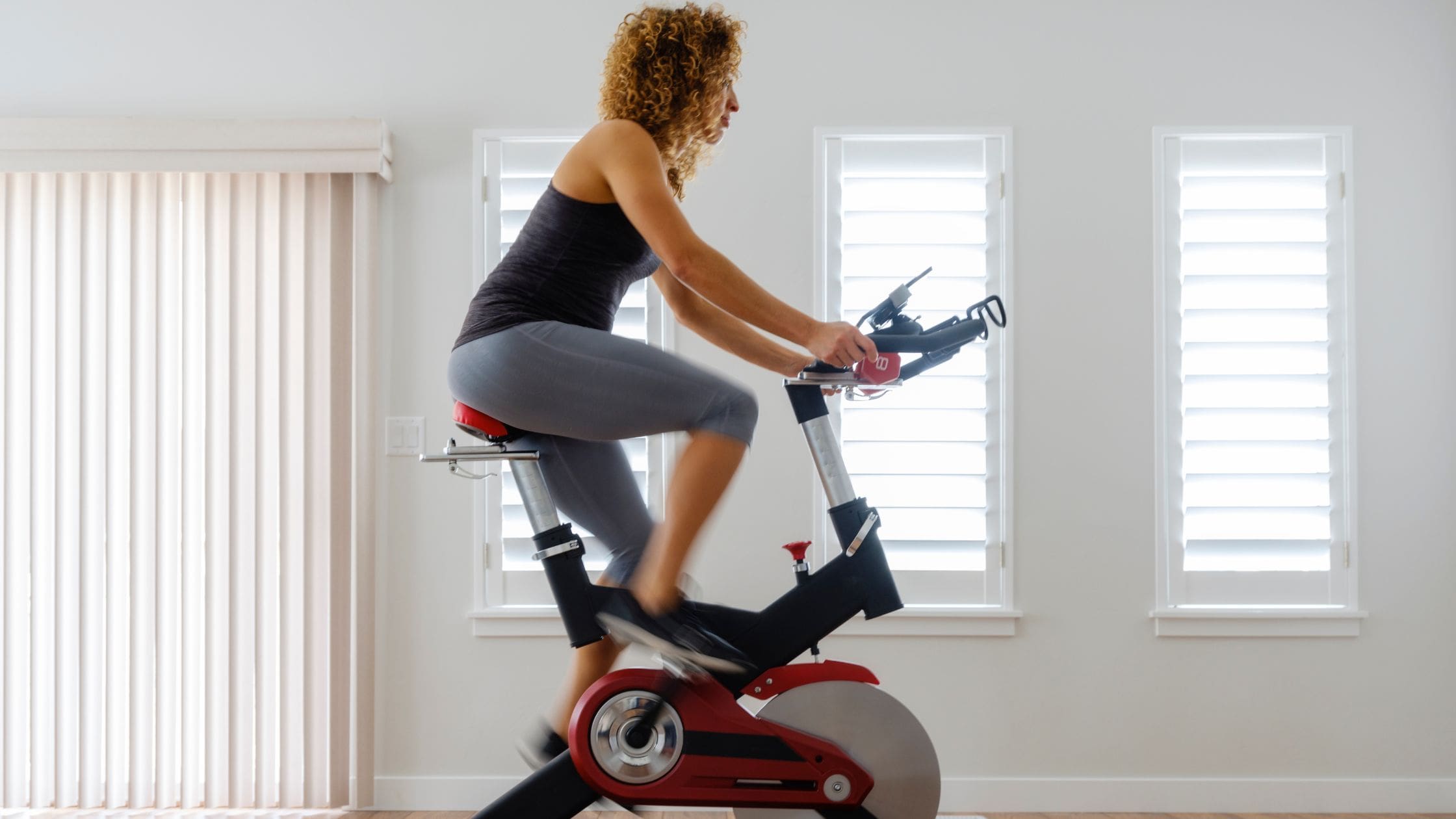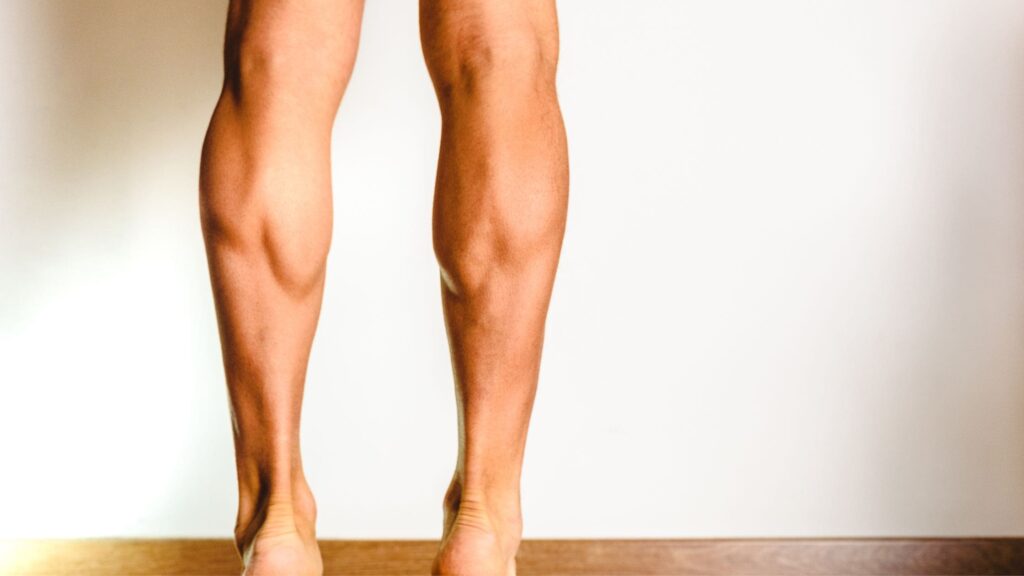People have been using exercise bikes since the late 19th century. Cycling is great fun and also comes with proven health and fitness benefits. With the home exercise bike market expected to grow 8.7% in the next five years, this post will introduce the stationary bicycle, an indoor exercise machine that you pedal just like a bicycle.
What is a Stationary Bike?
A stationary bicycle is a popular type of cardiovascular equipment that is super easy to use. You’ll also hear it referred to as an exercycle, spin bike, spinning bike, exercise bike, or exercise bicycle.
These exercise bikes have very familiar parts such as a saddle, handlebars, and pedals. It looks very much like an ordinary bicycle but without the wheels.
History of Stationary Bike
The stationary bicycle was invented by an American chemist, Keene Dimick, in 1968. The bike was equipped with electronics that he used to track his progress while exercising. Keene and his wife Adele were passionate about bicycling and believed it could make people fit and help them live longer. They decided to call the invention the Lifecycle.
Keene was planning to sell the Lifecycle to business people. He invested millions of dollars in his plan but failed to succeed. Eventually, he sold the rights to his invention to Ray Wilson in the 1970s.
The idea didn’t take off immediately and sales were very slow. However, Wilson’s partner, Augie Nieto, suggested they hand their invention over to 50 major US health club managers and owners. The Lifecycles were given away for free and the strategy worked because sales of the Lifecycle were brisk.
What are the Components of a Stationary Bike?
While there are many different types of exercise bikes, they are similar in terms of their component parts. The main components of a stationary bicycle include:
Frame
The frame is an integral part of every stationary exercise bicycle. It is usually made of metal.
Pedals and Flywheel
The pedals of exercise bikes are connected to the flywheel using a belt or chain, much the same as a road bike. When the flywheel spins, the pedals move at the same time. The flywheel stores momentum and ensures a smooth ride. It also provides constant resistance which challenges your muscles.
The flywheels can be either at the front or back of the bike and vary in terms of weight. A heavy flywheel provides more resistance and a smoother ride than a lighter flywheel. Heavy flywheels take a lot of effort to get going, which means they might not be quite so good for beginners or people with joint problems. Heavy flywheels can be hard on the knees.
Lighter flywheels are easier for getting your workout started and for moving the stationary bike around.
Resistance system
The resistance system is something you can use if you want to get off the bike but can’t wait until the flywheel slows down. If you hold down the resistance knob, it activates the brake.
The resistance system also simulates changing gears, like on an outdoor bike. When the resistance is set to low, it’s similar to cycling on a flat road. Higher resistance settings make it feel like you’re cycling uphill.
Seat
These are very similar to the seats you find on a regular bike. Most seats will be padded, but even so, they can become uncomfortable when cycling for long periods.
The seat is a component part you can replace with something more comfortable if you can find it. An alternative is to buy padded biking shorts or use a gel seat cover.
The seat is attached to the bike’s frame using a seat post. These tend to be adjustable so you can customize the riding experience.
Handlebars
Handlebars are really there to help you stabilize and you can usually adjust these to a position that feels most comfortable.
Aim for a cycling position that allows you to keep your elbows slightly bent and your back straight. In terms of horizontal positioning, the most comfortable position is one where the handlebars are about a forearm’s distance from the saddle.
Display Console
With a bike trainer display console, you’ll be able to track your speed, distance, and other key metrics.
Brakes
Some, but not all exercise bikes have a braking system. It can be direct contact or a magnetic braking system. When the user applies brakes to the flywheel, resistance is created.
With direct contact braking, it’s friction that provides resistance. The brake is applied directly to the flywheel to reduce the rotational speed. A bike with this type of braking system is very accurate. The friction is provided by brake pads that are usually made out of felt.
Magnetic brake systems have an advantage over direct contact braking in that their parts do not suffer wear and tear. Electromagnetic induction is what provides resistance.
Drive system
The drive system of exercise bikes is either chain or belt. These are what connect the flywheel to the pedals and allow the flywheel to spin and create resistance.
Chain drive systems are the most popular because they stand up to heavy use. They also give a better feeling of cycling outdoors.
The downsides of a chain drive system are that it can be much noisier than a belt and also requires more maintenance, including regular lubrication of the chain which can be quite messy.
A belt drive system requires minimal maintenance. The belt is typically made of rubber which provides a silent and smooth ride. Belts are prone to stretching and slipping over time. However, they are fairly durable.
Water Bottle Holder
This is not something you’ll find on all exercise bikes but it can be a helpful addition. You’ll be able to stay hydrated without having to stop exercising.
Accessories
There are several different accessories you might look for to enhance your stationary bicycle experience. They include:
- A fan that will help to keep you cool during your workout
- Heart rate monitor or smartwatch that keeps your vitals in check
- Headphones or earbuds so you can crank your playlist during your ride
What are the Different Types of Stationary Bikes?
There are several different types of exercise bikes. Let’s introduce you to the most common.
Upright Exercise Bike
An upright exercise bike is very similar to a traditional outdoor bicycle. An upright exercise bike has handlebars in front and an upright seating position.
Uses
- Full body workouts
- Good cardio workouts
- Strengthening the core and lower body muscles.
Price of a new upright bike: $80 – $3,500
Price of a used upright bike: $40 – $4,793
Recumbent Bike
A recumbent bike has a reclining seat position along with back support. This support for the back reduces lower back and joint strain. A recumbent bike is also lower to the ground, making it easier to get on and off.
Uses
- Recumbent bikes are Ideal for those with back issues
- Recumbent bikes provide a more comfortable and low-impact workout
- You get a focused lower-body workout with a recumbent bike
Price new: $119 – $6,995
Price used: $60 – $5,045
Indoor Cycling Bike (Spin Bike)
Indoor cycling bikes are also known as spin bikes. They are designed for fast-pedaling and to increase the number of calories burned. They have a built-in resistance knob that allows users to alter resistance. The seats and handlebars are easily adjusted to fit a person’s stature.
Uses
- Intense workout
- Mimic the feel of outdoor road cycling
- High-intensity workouts
- Indoor cycling classes.
Price new: $119 – $888
Price used: $195 – $500
Dual-Action Stationary Bike
A dual-action stationary bike combines lower and upper body workouts thanks to the moving handlebars. With moving handlebars as well as pedals, a dual-action bike works out the user’s leg muscles along with their arm and shoulder muscles.
Uses
- Lower and upper body workouts
- Low-impact workout
- High level of aerobic and cardiovascular exercise
Price new: $170 – $500
Price used: $60 – $1,010
Air Bike (Fan Bike)
An air bike is a cross between a traditional exercise bike and an elliptical. Air bikes use air resistance generated by a fan or flywheel to provide resistance. As you pedal faster, the resistance increases.
Uses
- High-intensity interval training (HIIT) workouts
- Upper-body exercise
- Low impact exercise
- For people undergoing physical therapy or rehabilitation
Price new: $138 – $1,100
Price used: $795 – $1,970
Ergometer (ERG) Bike
An ergometer bike (ERG) is designed to measure the amount of work a user does by pedalling the bike. These bikes are commonly used by professional athletes and sports trainers because they allow the user to assess performance and track progress.
Uses
- Fitness tests
- Measuring cardiac performance
Price new: $147 – $3,995
Price used: $200 – $500
What are Stationary Bikes Good For?
A stationary exercise bicycle is easy to use for almost every age group and generally safe to use. Let’s take a quick look at some of the things these stationary bicycles are good for.
Low-Impact Exercise
Compared to other forms of cardio exercise, particularly high impact aerobic exercises, stationary biking is considered to be less intense exercise exercise. It is easy on your heart and joints.
Boosts Heart and Cardiovascular Health
Stationary biking is a great form of cardio exercise. Stationary bicycles increase your heart rate and encourage your heart muscles to work hard to keep up with increased oxygen demand. This helps to improve your heart health, can help lower blood pressure, and has a positive cardiovascular impact.
Improves Strength
A stationary exercise bicyclegives users the option of adjusting the wheel’s resistance which means you have to pedal harder. The increased resistance helps to strengthen your lower body and legs.
Reduces Diabetes Risk
Cycling using cardio equipment is a form of exercise that can help you lose weight. Diabetes is closely related to obesity therefore, losing weight reduces the risk of becoming diabetic.
Improves Joint Mobility
Several different joints benefit from this exercise on stationary bicycles of exercise such as the hip joints, ankles, and knees. The pedaling motion means your joints are rotating which strengthens them and improves their range of motion.
Boosts Brain Function
There have been studies that looked at stationary biking and its effect on cognitive function. It has been confirmed that stationary biking improves memory, attention, and cognitive function. During this type of workout, your body releases good hormones which makes biking good for your mental health.
Reduces Stress and Improves Your Mood
All types of workouts on stationary bicycles help to release “feel good” hormones. This means you feel good when your workout ends. In addition, you’re burning calories and sweating which reduces stress and encourages the release of serotonin.
Improves Balance
Stationary biking has been shown to help improve gait, coordination, and balance. The elderly and people recovering from a chronic stroke would find stationary biking very useful. It can also help to prevent fractures and falls in the elderly.
Increases Endurance
If you add stationary biking to your exercise regime, it can help speed up your stamina and endurance. You’ll soon find you can finish your strength or cardio training easily and without getting out of breath.
Great For Toning
Upright stationary bikes are an excellent form of exercise if you want to tone your lower body. It works on your calves, quads, hamstrings, and glutes.
Can You Lose Weight on a Stationary Bike?
You can burn calories when using a stationary exercise bike. It’s estimated you could burn up to 80 calories in just 10 minutes. However, the number of calories burned does depend on the exercise intensity and your body weight. It’s also a good way to lose fat from your lower body because it activates your calves, quads, hamstrings, and glutes.
What Muscles Are Toned From a Stationary Bike?
Use an exercise bike and you’ll be working one of the most important muscles in your body, namely your heart. However, it’s not the only muscles that will be getting a good workout. The muscles targeted by a stationary exercise bike include the following.
Quadriceps and Hamstrings
These are the muscles of the front and back of your thigh. They are constantly working while you pedal.
Glutes
The gluteal muscles or your glutes are also working out when you push the pedals. You have large, medium, and small buttock glutes.
Calves
These are also called triceps sural and you find them at the back of your leg.
Upper Body Muscles
In addition to the lower body muscles, you’re also working those in your upper body which includes your abdominal muscles or abs, back muscles, and your biceps and triceps.
Can You Get in Shape Just on a Stationary Bike?
Yes, you can get in shape using just a stationary bike but don’t expect it to happen overnight. You’ll need to work out regularly and be constant. You could start seeing results in a few weeks.
What are the Advantages of Using a Stationary Bike?
There are many advantages to using a stationary bike for exercise. They include the following:
- Low-Impact Workout: You’re using smooth movements to strengthen joints and bones without putting too much pressure on them.
- Customizable Workout: You can tailor your workout to meet your needs and goals.
- Lower Cost: A Stationary exercise bike is much cheaper than the cost of a regular gym membership.
- Versatility: You can target different muscle groups, change up your speed, and increase resistance.
- Motivation: Many stationary bikes have features that can help keep you motivated, such as built-in workout programs, virtual courses, and performance tracking.
- Stationary Bike Workouts Are Safe: Cycling outdoors is good exercise but comes with certain hazards.
- Convenient: Stationary bikes can be used at home or in a gym, making them a convenient option for people who want to exercise without leaving their houses.
- Customizable bike workout: You can customize your workout depending on your needs.
- Stationary Bikes Are Approachable for All Levels of Fitness: Whatever your level of fitness, stationary exercise bikes are easy to use.
- Stationary Bikes Are Great for HIIT Training: HIIT training is great for weight loss.
- Stationary Bike Workouts Are More Efficient Than Outdoor Biking: When you’re cycling in your home you don’t have to worry about the elements, road conditions, or traffic.
What are the Disadvantages of Using a Stationary Bike?
As well as the many benefits, there are also some disadvantages worth mentioning. They include the following:
- Limited muscle engagement: You’re only using your muscles in a specific way.
- Overuse injuries: Repetitive strain injuries could be an issue.
- Boredom: Doing the same type of exercise every day can become boring.
- Cost: Some stationary exercise bikes are very expensive.
- Space: Depending on the size and type of stationary bike you choose, it may take up a significant amount of space in your home or gym.
- Lack of outdoor scenery: It can get a little boring with just your four walls to look at.
- Maintenance: Like any piece of equipment, stationary bikes require maintenance to keep them functioning properly.
Is There Any Risk in Using a Stationary Bike?
Using an exercise bike comes with some risks, but only if you’re doing it wrong. Some of the most common mistakes include:
- Overdoing the exercise and hitting a weight loss plateau
- Overdoing the exercise can increase the risk of injury such as ligament and muscle strains
- Not giving your muscles time to repair
- Not including other forms of exercise
Who Should Use a Stationary Bike?
A stationary bike is a good piece of gym equipment for the following people:
- People with joint issues or injuries
- People who want to boost their cardio fitness
- People who want to lose weight or are on a weight-loss plan
- People who want to strengthen their legs and lower body
- Beginners who are just starting to build their fitness
- People who want to boost their strength and stamina with interval training
Who Should Not Use a Stationary Bike?
Stationary bikes are one of only a few types of exercise equipment that can be used by almost anyone, young, and old, with varying levels of fitness, and people recovering from injuries or suffering joint pain.
The resistance levels of a bike can be adjusted to suit individual needs and requirements. However, as with all forms of exercise, it’s important to consult your doctor before you start any exercise program. This is particularly important for people who have conditions such as cardiocirculatory problems, hypertension, or people who are obese.
A certified personal trainer will also help you achieve your goals.
Do Stationary Exercise Bicycles Require Maintenance?
Exercise bicycles do require a certain amount of maintenance if you want to ensure its longevity, safety, and optimum performance. Maintain your bike regularly and it will prolong its life and help to prevent break breakdowns.
Let’s share a list of some of the general maintenance tasks you should perform:
- Clean the bike: Regularly remove dust, sweat, and dirt by wiping down the frame, handlebars, and seat. Wipe down the frame, seat, and handlebars regularly to remove dust, sweat, and dirt. Use a damp cloth and mild soap and water. Dry with a clean cloth. Don’t use harsh chemicals as these could damage the bike’s surface.
- Inspect for wear and tear: Closely inspect important components such as the flywheel, handlebars, pedals, and seat. You’re looking for signs of wear, damage, or loose parts. Address any issues you find promptly because this will prevent further damage or accidents.
- Lubricate moving parts: A stationary bike’s moving parts include the resistance system, flywheel, and chain. When these moving parts are correctly lubricated, it helps reduce friction and wear and ensures smooth operation.
- Tighten bolts and fasteners: You must inspect nuts, bolts, and other fasteners regularly to ensure they are tight and secure. If components become loose, your bike will become unstable and this could lead to accidents or damage.
- Check the resistance system: You’re looking for signs of wear or damage. Should you find these, adjust or replace them according to the manufacturer’s guidelines.
- Inspect the electronics: Electronic elements might include a heart rate monitor or a display screen. You should check for any issues or malfunctions. Ensure electrical connections are secure and replace batteries as and when necessary.
As a final tip in terms of maintenance, always follow the manufacturer’s recommendations. When you buy your stationary bike, the first thing you should do is read the bike’s user manual and look for specific maintenance guidelines and schedules.
There are several different types of stationary bikes and each will have unique maintenance requirements.
How Long Does a Stationary Bicycle Last on Average?
A stationary bicycle’s lifespan will vary depending on how well you look after it, the frequency and intensity of use, and the quality of the bike.
On average, you can expect a good quality bike to last between 5 and 10 years. It could last even longer with proper care and regular maintenance.
Here are some of the factors that can affect your stationary bike’s lifespan::
- Quality and construction: A high-quality bike that’s got a sturdy frame and well-built components will likely last longer than a cheaper, lower-quality model. If you can invest in a reputable brand, this is also going to increase its longevity.
- Frequency and intensity of use: The more you use your bike, the greater the wear and tear which inevitably shortens its lifespan. On the other hand, a good-quality bike will be designed to withstand regular use and last longer.
- Maintenance: Regular maintenance, such as the tasks mentioned above, can help prolong the lifespan of your bike. If you follow the manufacturer’s recommendations for maintenance it will keep the bike in good working condition.
- Storage: Store your bike where it is dry, cool, and well-ventilated because this will help to prevent rust and component damage.
What to Check When Choosing a Stationary Bike?
If you like what you’ve read so far and are interested in purchasing a stationary bike, there are some things to keep in mind:
- Comfort: Look for a bike with a comfortable saddle you can adjust to the optimum height.
- Resistance: Being able to adjust the resistance will allow you to alter your bike workout according to your goals and fitness levels.
- Display: A display screen will show your speed, heart rate, and the number of calories you’ve burned.
- Optional extras: Built-in fans, water bottle holders, and built-in acoustic sound systems are just a few examples.
- Price: Choose the best bike for your budget.
- Warranty: Ideally, you want a warranty that provides lifetime coverage for the bike’s frame, at least two or three years of coverage for major moving parts, and a year for labor.
- Brand and reviews: Do your research and check out reviews before you make your purchase.
What is the Best Brand for Stationary Bikes?
There are plenty of popular brands, but a few that stand out from the others include the following:
- Peloton
- Precor
- Yosude
- Life Fitness
- Bowflex
- Star Trac
- Echelon
- True Fitness
Where to Buy a Stationary Bike?
There are plenty of places you can visit if you’re ready to buy a stationary bike. There may be a fitness equipment dealer close to where you live or you might choose to do your shopping online.
Best Used Gym Equipment, located in Miami, FL is a leading stationary bicycle retailer. We offer a wide range of top brands to fit any budget.
Choose from various styles, including upright bikes for cardio or advanced options for a more challenging workout. With adjustable features, resistance control, and monitoring capabilities, our stationary exercise bikes for sale provide an effective and engaging fitness experience.
Conclusion
When it comes to investing in this type of bike there are lots of things to consider. Comfort, functionality, size, and price are key. Overall, you can enjoy many low-impact workouts and you’ll find them a fun way to engage in physical activity.
FAQs
1. Is a stationary bike good for beginners?
Yes, a stationary bike is great for beginners. There’s nothing complicated to learn and you can start slow with minimal resistance and change the settings as your fitness improves.
2. Is a stationary bike effective?
A stationary bike is effective if you want to burn calories and body fat and strengthen your muscles, lungs, and heart at the same time.
3. Is it better to walk or ride a stationary bike?
Cycling can be better for burning more calories. It also helps increase lower-body strength. However, walking may help with bone density and it tends to cost much less.















